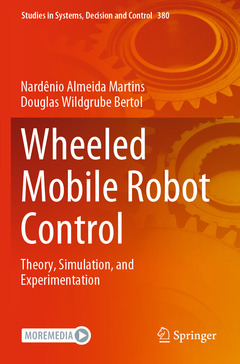Wheeled Mobile Robot Control, 1st ed. 2022 Theory, Simulation, and Experimentation Studies in Systems, Decision and Control Series, Vol. 380

1. Chapter 1 "Model development and control objectives"
1.1 Introduction
1.2 Development of the kinematic model with or without uncertainties and/or disturbances
1.3 Development of the dynamic model with or without uncertainties and/or disturbances
1.4 Trajectory tracking control problem
2. Chapter 2 "Classic control"
2.1 Introduction2.2 Problem formulation
2.3 Control design
2.4 Simulations using Matlab and/or MobileSim simulator
2.5 Experimental results using PowerBot robot
2.6 Analysis and discussion of results
2.7 Final considerations
3. Chapter 3 "Robust control: first order sliding mode control technique"
3.1 Introduction
3.2 Problem formulation
3.3 Control design
3.4 Simulations using Matlab and/or MobileSim simulator
3.5 Experimental results using PowerBot robot
3.6 Analysis and discussion of results
3.7 Final considerations
4. Chapter 4 "Adaptive robust control: neural sliding mode control technique"
4.1 Introduction
4.2 Problem formulation
4.3 Control design
4.4 Simulations using Matlab and/or MobileSim simulator
4.5 Experimental results using PowerBot robot
4.6 Analysis and discussion of results
4.7 Final considerations
5. Chapter 5 "Adaptive robust control: adaptive fuzzy sliding mode control technique - Variant I"
5.1 Introduction
5.2 Problem formulation
5.3 Control design
5.4 Simulations using Matlab and/or MobileSim simulator
5.5 Experimental results using PowerBot robot5.6 Analysis and discussion of results
5.7 Final considerations
6. Chapter 6 "Adaptive robust control: adaptive fuzzy sliding mode control technique - Variant II"
6.1 Introduction
6.2 Problem formulation
6.3 Control design
6.4 Simulations using Matlab and/or MobileSim simulator
6.5 Experimental results using PowerBot robot
6.6 Analysis and discussion of results
6.7 Final considerations
7. Chapter 8 "Vision-based control by digital image processing"
7.1 Introduction
7.2 Problem formulation
7.3 Control design
7.4 Simulations using Matlab
7.5 Experimental results using MiaBot Pro robot
7.6 Analysis and discussion of results7.7 Final considerations
8. Chapter 7 "Robustness to kinematic and/or dynamic disturbances: integral sliding mode control technique"
8.1 Introduction8.2 Problem formulation
8.3 Control design
8.4 Simulations using Matlab
8.5 Experimental results using MiaBot Pro robot
8.6 Analysis and discussion of results
8.7 Final considerations
9. Chapter 9 "Dynamic control considering actuator dynamics"
9.1 Introduction
9.2 Problem formulation
9.3 Control design
9.4 Simulations using Matlab
9.5 Analysis and discussion of results
9.6 Final considerations
10. Chapter10 "Formation control of wheeled mobile robots"
10.1 Introduction
10.2 Problem formulation
10.3 Control design
10.4 Simulations using Matlab
10.5 Analysis and discussion of results
10.6 Final considerations
Nardênio Almeida Martins has completed M.Sc. in Electrical Engineering from the Federal University of Santa Catarina (1997) and Ph.D. in Automation and Systems Engineering from the Federal University of Santa Catarina (2010). He is currently an associate professor in the Department of Informatics and the Graduate Program in Computer Science at the State University of Maringá and a member of the research groups "Robotics" of the Department of Automation and Systems of the Federal University of Santa Catarina—Florianópolis Campus and the "Automation of Systems and Robotics Group" at the State University of Santa Catarina—Joinville Campus, working mainly on the following research topics in robotics: robot manipulators, joint space, operational space, wheeled mobile robots, trajectory tracking, adaptive control, robust control theory, neural networks, fuzzy logic, and Lyapunov stability theory.
Douglas Wildgrube Bertol has completed M.Sc. in Electrical Engineering from the Federal University of Santa Catarina (2009) and Ph.D. in Automation and Systems Engineering from the Federal University of Santa Catarina (2015). He is currently an associate professor in the Department of Electrical Engineering and the Graduate Program in Electrical Engineering at the Universidade do Estado de Santa Catarina and a member of the Systems Automation and Robotics Research Group (GASR) at the same University, working mainly in subjects of applied robotics, mobile robots, trajectory tracking, sliding mode control theory, neural networks, fuzzy logic, and Lyapunov stability theory.Addresses theoretical, scientific, and practical aspects of differential-drive wheeled nonholonomic mobile robots
Provides mathematical modeling of the kinematics and dynamics of differential-drive wheeled nonholonomic mobile robots
Presents the design, implementation, and performance of trajectory tracking control systems
Proposes kinematic and dynamic trajectory control designs of differential-drive wheeled nonholonomic mobile robots
Contains simulation and practical applications that enable the developer to use creativity and imagination to modify, alter, or redo control system designs in kinematic and dynamic scope
Gives source code of the control system designs, both kinematic and dynamic
Promotes to the related areas an instrument of pedagogical application
Date de parution : 08-2022
Ouvrage de 209 p.
15.5x23.5 cm
Date de parution : 08-2021
Ouvrage de 209 p.
15.5x23.5 cm
